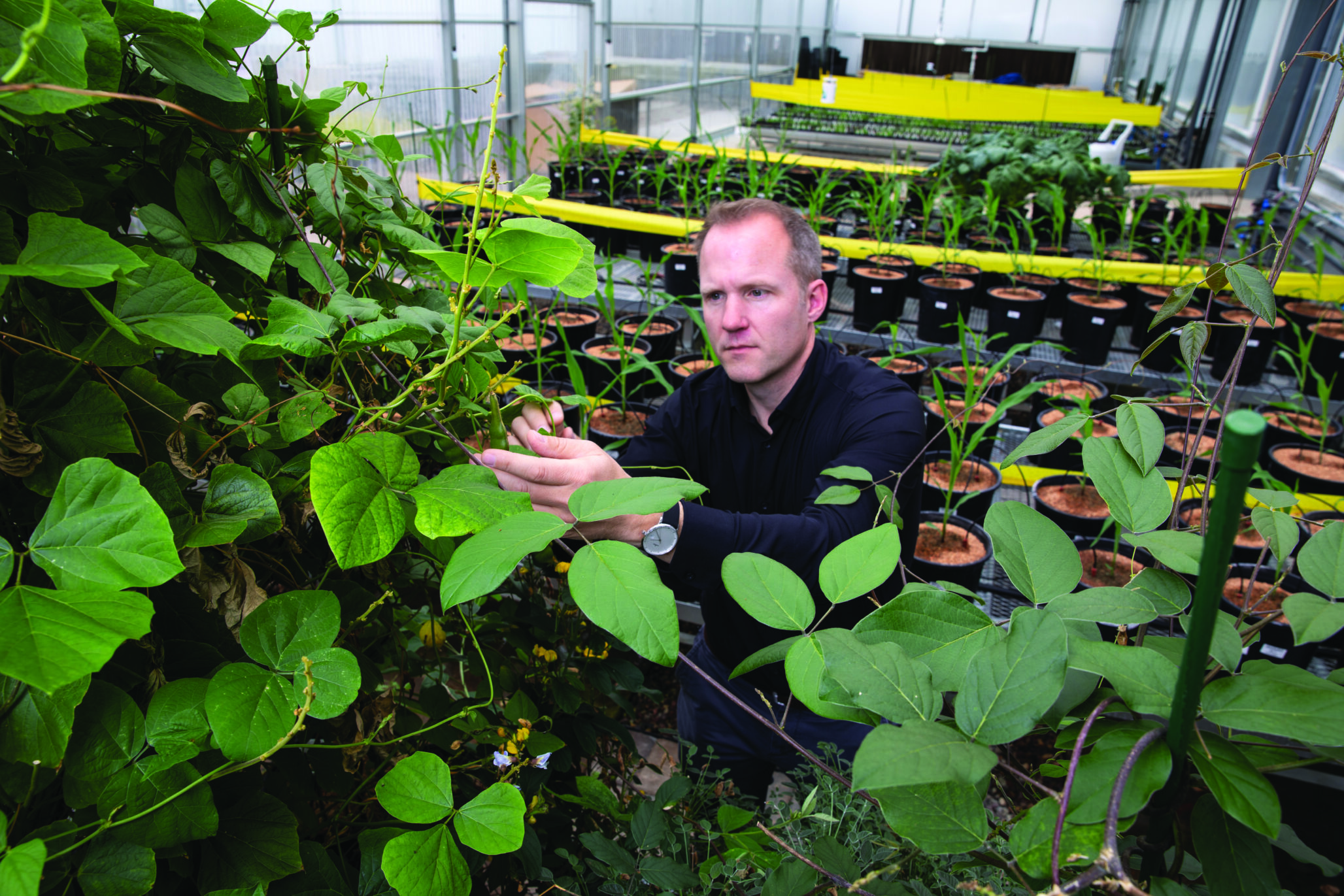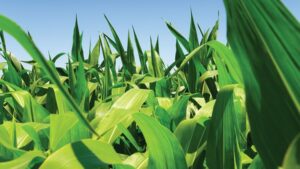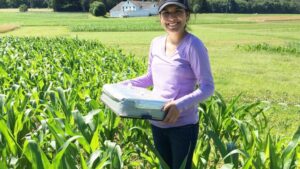About half of the fertilizer used in the United States goes to grow corn crops. A team of 27 labs across the country are working to find ways to create a more nitrogen-efficient corn production system that would be good for farmers and for the environment.
Nitrogen application plays a vital role in modern agriculture, bringing positive impacts on production from enhanced crop growth to increased crop productivity, to improved crop quality and balanced crop nutrition. However, it also carries negative impacts. In addition to its financial cost to farmers, nitrogen can cause significant environmental impact through run-off and greenhouse gas emissions.
Edward Buckler, a research geneticist with the U.S. Department of Agriculture’s Agricultural Research Service (USDA ARS) and an adjunct professor at the Cornell University School of Integrative Plant Science, is studying how agriculture can mitigate nitrogen use’s environmental impact. He is leading a collaborative effort across the United States to create a more nitrogen-efficient corn production system. The team’s strategies include adjusting planting schedules, optimizing nitrogen use and incorporating genetic traits from wild relatives of corn. These innovations aim to not only enhance sustainability but also potentially boost crop yields: a win-win for all.

Traditionally, nitrogen enters the cropping system through the application of a significant amount of fertilizer, resulting in large amounts of nitrate production. While a portion of nitrates are used to grow the crop, nitrate is highly mobile so can move within the soil profile and leach into waterways. It can also undergo reactions that lead to the emission of nitrous oxide, a greenhouse gas.
“Agriculture as a whole, through the flow of nitrogen into protein, is responsible for about 11% of U.S. greenhouse gas emissions,” Buckler explains. “The same type of thing is happening with the runoff of nitrogen into our waterways. We move some to the atmosphere, and we lose some in our water.”
While management practices can account for some of the losses, the challenge is bigger than how farmers farm.
“We’re just not very efficient at moving that nitrogen into protein that we can eat, and that results in water pollution issues and greenhouse gas emissions that are substantial,” Buckler says.
In fact, whether a legume fixes nitrogen from the atmosphere or has access to nitrogen industrially produced as fertilizer, about 87% of nitrogen is lost before reaching the consumer, says Buckler.
He’s committed to finding a better way.
Currently, about half of the fertilizer used in the United States is applied to corn crops. Buckler is leading a team of 27 labs across the country to find ways to create a more nitrogen-efficient corn production system.
Lowering protein
One key goal for the team is to decrease corn’s protein level. Because nitrogen is key to protein synthesis, less protein means less required nitrogen.
For the most part, lower-protein corn will not affect its end-use value, as corn’s primary value is its starch content. In a traditional dry-grind ethanol production process, for example, ethanol is produced from corn’s starch content, not its protein. When corn is used for hog or poultry feed, the primary feed value is in the corn’s starch and synthetic amino acids can be added to fulfill protein requirements.
“What we want is to shift to a system where we build up a large pool of organic nitrogen (in the soil),” Buckler says. “Then we essentially reuse that and it cycles through so we can apply a lot less fertilizer. We can then cut down on both nitrous oxide and the leaching problem.”
Earlier planting
Another key opportunity the research team is tackling to make more efficient use of nitrogen is earlier planting. In early spring, soil microbes ‘wake up’ and naturally convert significant amounts of nitrogen to nitrate in the soil. Because crops aren’t generally planted so early, this nitrate isn’t absorbed by plants. Rather, it tends to be lost into the water system and to the atmosphere. Shifting planting earlier would enable crops to use that early nitrogen, which Buckler explains would substantially cut down nitrogen losses. In the Midwest that might mean planting at the beginning of April instead of May.
“In the southern parts of the U.S., we are even considering making corn cold-hardy enough that it may be more like winter wheat,” Buckler says. “That essentially makes corn into its own cover crop.”
Buckler says developing cold-hardy corn that suits areas where wintertime temperatures go as cold as about 20°F could be achievable in the long term.
Natural nitrogen cycling
A third way the research team is striving to improve nitrogen use efficiency is by plant breeding: introducing genetics that would enable corn plants to move nitrogen from leaves and stems back to their roots at the end of the growing season, which is what perennial plants do.
Corn has wild relatives with this desired trait. For example, gamagrass is cold tolerant, used for forage, and grows as far north as Wisconsin and Massachusetts. Maize has a perennial wild relative found in Mexico called Zea diploperennis that remobilizes nitrogen at the end of the growing season back down to its roots.
“We’re not going to make a perennial crop, but these relatives of corn have all the traits we want,” Buckler says. “We know the genetics we need to achieve this type of thing are already out there, and we think that this set of traits can provide some real benefit when combined with a range of other agronomic approaches. With this type of corn in conjunction with improved rotations and fertilizer applications, we think we’re on the order of cutting down greenhouse gas emissions by over 50% and reducing fertilizer inputs by over 50%.”
Buckler realizes this will take some time to implement.
“I think some of the things like lower grain protein, we can start to select on right away so there’s less nitrogen demand,” Buckler says. “Cold tolerance is a hard trait.”
High-tech solutions
He believes genomic tools will make cold tolerance possible.
“We’ve been able to use all these genomic tools to look at about 500 wild species related to corn,” Buckler says. “The first corn genome cost about $30 million to sequence and now we’ve been able to look at 500 other species a decade later for maybe a couple million dollars.”
Having available wild species from which to draw desired traits speeds the process. Researchers have started identifying the wild relatives’ genes and are testing key genes to cross into corn.
“I think at the end of five years, we’ll have identified the key genes we need for this process, and then at that point we will work carefully with industry to start deploying those in the next five years,” Buckler says.
He further explains that researchers can use standard breeding and transgenics, but that the most efficient method likely is gene editing.
“Corn is an annual, and it’s closest wild relatives are annuals,” Buckler says. “But if you go back in time, all its ancestors were perennials. We’re just adding little bits of that back in.”
Buckler’s team has worked in close consultation with corn grower groups and foresees maintaining yields, if not improving them.
“If we’re planting earlier, every few degrees of cold tolerance we get a yield bump,” Buckler explains. “If we can achieve overwintering in parts of the Southern U.S., we might see up to a 30% yield bump.
I think that the wins in dealing with nitrogen are threefold–fewer input costs, less water pollution, and fewer greenhouse gas emissions. Whichever perspective you’re coming at this from, we all want this to work.”













